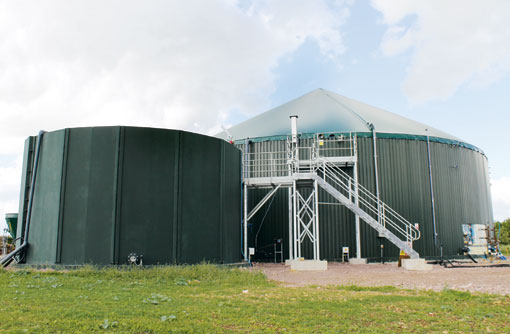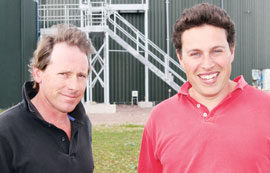Making the most of biogas

Of all the forms of renewable energy, anaerobic digestion probably presents the greatest challenge for poultry farmers.
The high nitrogen content of chicken litter means it can only be added to the AD feedstock in limited quantities, or it will kill the bacteria in the digester and destroy the process.
But Jeremy Iles (pictured, on the right), who produces 170,000 standard broilers for processor Hook 2 Sisters on his farm near Cirencester, Gloucestershire, has overcome that problem by forming a joint venture with neighbouring pig farmer James Hart (pictured, on the left), combining the manure from both of their enterprises.
 “We’ve known each other for many years, and already share farm our combined 600ha of arable land,” he said.
“We’ve known each other for many years, and already share farm our combined 600ha of arable land,” he said.
The AD plant was self-built at Mr Hart’s 400-sow pig unit in the second half of 2010, and was fired up for the first time in April. The feedstock is made up of 5t a day of chicken litter, 40t a day of pig slurry, 4t a day of fym and 4t a day of home-grown maize silage. “A 3,000t cow’s stomach” is how Mr Hart describes it.
The methane is used to run a 350kW generator, though the maximum that can be delivered to the national grid from the site is 250kW. “I also use an average of 32kW on the pig farm, while the heat from the generator is used to warm my pig manager’s house,” said Mr Hart.
Unfortunately, Mr Iles’s poultry farm is too far away to use any of the heat or electricity from the AD plant. “But at some point we could run a gas line to my sheds for heat and power,” he said.
Total cost of the project is put at £1.2m, including £180,000 on a silage clamp and muck storage area and £100,000 on a grid connection. This was partly offset by a £430,000 Rural Development Programme for England. This innovations fund was set up to promote European investment in new technologies in rural areas.
Because of the grant, they are not able to claim the Feed-in Tariff, worth 13p/kWh, but do receive a Renewable Obligation Certificate payment, worth between 9p and 10p/kWh.
Combined with electricity sales of 5.4p/kWh, the income for the plant comes to an estimated £350,000 a year. After deducting other costs, such as interest, maize production, maintenance and labour (about two hours a day), the two men are anticipating the project will have paid for itself within five to seven years.
On top of that, there is the free heat, as well as a two-thirds reduction in the fertiliser requirement for the arable operation and an improved arable rotation. Other advantages are that the project provides a new interest for the farm staff, it reduces livestock odours and generates a carbon saving of 10,000t a year.
“The finances of anaerobic digestion look very exciting and it is an enterprise that fits very well with the existing farm enterprises,” said Mr Hart.
He estimates 100ha of maize would produce about £280,000 revenue when put through the AD plant, compared with about £150,000 for 100ha of wheat.
Investing in AD is not without its challenges, however. “The banks can be tricky, and we were very dependent on our grant,” said Mr Hart. “But hopefully, as more AD plants are built, the banks will understand they are really good news for UK farming’s finances.”
Getting a suitable grid connection can also be a problem, and there are also costs involved in getting or varying pollution control permits.
But the rewards are considerable and, with this motivation, they can envisage expanding the site to make better use of the heat with a plant that could supply heat and electricity to the local school and housing.
The anaerobic digester at Mr Iles’s Homeleaze Farm was built with the full support of landowner, the national education charity the Ernest Cook Trust.
The Trust’s director Nicholas Ford said: “This is a remarkable achievement and a ground-breaking project. We are very proud of the fact that two of our tenants are at the very cutting edge of environmentally-friendly farming practices.”
Mr Iles added: “It is very rare for two tenant farmers to be able to realise a project like this, and it’s really a credit to our landowner the Ernest Cook Trust, which has supported us and given us the confidence to invest in our farms.”
